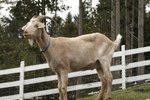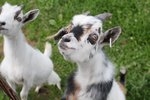Relatively few goat breeds sport long hair. Those that do are generally raised specifically for their long coats, and their names are synonymous with luxurious garments.
Pygmy Goats
Certain pygmy goats are long-haired. These dwarf animals boast a medium to long, straight coat, and males often have beards and a substantial mane. The pygmy goat makes a good pet and can also be used for dairy purposes. Your goats can efficiently and happily consume brush on your property.
For small goats, a large doghouse in an run fenced to keep predators out can serve as suitable accommodations. Provide your pygmy goats with toys and objects to climb on -- an old picnic table is much appreciated. If not on pasture, most pygmy goats do well on grass or timothy hay, along with constant access to fresh water.
Tips
Herd animals, goats enjoy the company of other goats. It's always a good idea to at keep at least two goats, although other herd animals -- such as sheep, horses and cattle -- can fill in if necessary.
Cashmere Goats
When you imagine or feel cashmere, "goat" might not be the first thing that comes to mind, but that's where this fine fiber originates. This ancient industry has its roots in China and the Middle East, and is relatively new to North America.
Cashmere goats aren't a particular breed, but rather a type. With cashmere goats, it's the soft undercoat, not the tougher guard hairs, that are used to create the fabric. Adult cashmere goats are sheared annually and may each produce up to 2.5 pounds of hair, of which approximately 20 percent is cashmere. Because their long coats provide good insulation, these goats are able to live outdoors with just basic shelter. Another plus -- they are less likely to climb or jump out of pens than other goats, so containing them isn't as much of a challenge as it often is with caprines.
Angora Goats
Angora goats produce mohair. Although larger than pygmy goats, Angora goats are smaller than most goat breeds. They are also far less hardy, so require housing in barns or dry, weatherproof sheds rather than typical goat run-ins.
Angoras are classified according to hair type. The "B" Angora has a flatter hair coat, while the "C" Angora's hair grows into long ringlets. Angoras as sheared twice annually, when their hair is between 4 and 6 inches in length. An Angora goat can produce up to 16 pounds of mohair per year.
Warnings
While some breeders cross Angora and cashmere goats, with the offspring producing a fiber known as cashgora, this isn't a particularly useful type of goat hair.
Writer Bio
Jane Meggitt has been a writer for more than 20 years. In addition to reporting for a major newspaper chain, she has been published in "Horse News," "Suburban Classic," "Hoof Beats," "Equine Journal" and other publications. She has a Bachelor of Arts in English from New York University and an Associate of Arts from the American Academy of Dramatics Arts, New York City.





